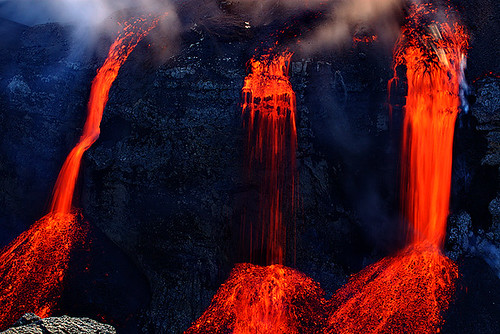Here's a quick science primer on what's what: Glass is an imperfectly arranged solid. Crystals have nearly perfect geometric arrangements of their atoms&molecules, like a neat stack of oranges. Glass is the same thing with disorder-- Amato's analogy is 'a fallen stack of oranges (with some grapes and such mixed in)'.
"Glass does not have this long-range order" says one Dr. Mysen., a geophysicist. So window glass = quartz crystal + spoilers and disorder. Glass forms because it typically cools too quickly to form perfect structure-- "the bonding behavior becomes more random and you get glass. This chaotic structure is why glass can take on just about any shape and why it breaks by shattering, rather than by cleaving along straight geometric planes the way crystals do".
The article has some great examples of naturally forming glass (look up, oh, 'tektites'). But candy?
among the most enticing forms of glass are the edible ones. Cotton candy, for one, forms when molten sugar (sucrose) in a hot and spinning bowl spits out of tiny holes and meets the cold air. With no time for the liquid sucrose to recrystallize, it freezes into threads of sweet, edible glass.When you eat cotton candy, you're chewing on tasty, sweet glass. Cue the way awesome science soundtrack. And try this: "A potato chip is a glass."
I'll repeat, because it's just that weird. A potato chip is a glass. "It is made up largely of starch molecules in a noncrystalline arrangement. "This is why a potato chip is crisp," [researcher Chris Young] says. "The chip shatters catastrophically when you bite into it." Young's a food researcher, or put more simply, a non-theoretical revenue-incentived molecular gastronomist, inventing new tasty dishes such as an edible pumice-like fruit volcano.
As for real volcanos, here's the Icelandic eruption's version of cotton candy:
Eyjafjallajokull's specific recipe for glass grains that float in the air includes silica, alumina, iron oxide, calcium oxide, and a half-dozen other oxides, according to a chemical analysis by researchers at the University of Iceland's Nordic Volcanological Center. During the eruption, a molten mixture of these was shot through an ice-filled crater at the summit. That provided the rapid cooling needed to make glass. Then, this nascent glass was pulverized into microscopic flecks by great blasts of steam and gas from the volcano.
   |
| Non-edible volcano (Eyjafjallajokull) |
So the next time you meet a scientist who says 'go chew on some broken glass', know that we either have a) your best interests at heart, b) a carnival concessions stand, or c) a volcano-based supervillian lair. Or all three.
Alex
Tuesdays at The Satellite Diaries and Friday at The Daytime Astronomer (twitter @skyday)





Comments